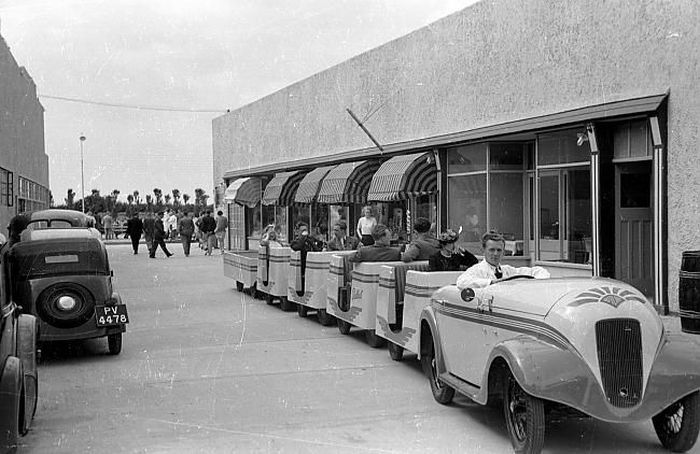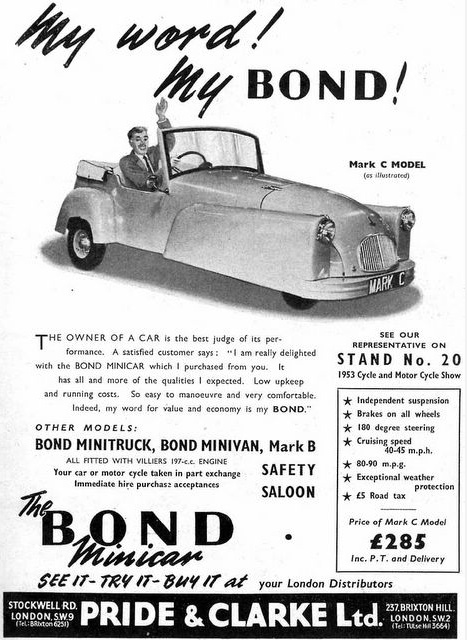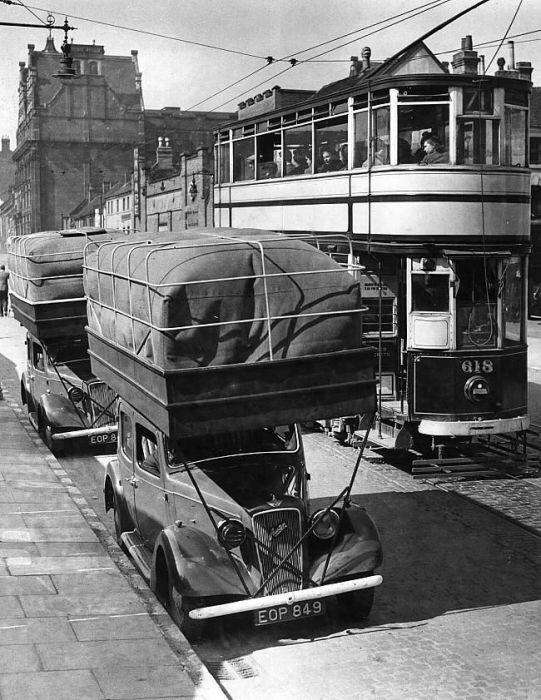March 2013
A friend sent these to me and I thought you might enjoy them. He supplied nothing of the vehicle type, country, year, photographer, etc… so I have undertaken some judicious research and surmised the rest. Somehow today’s cars just don’t have the joie de vivre of these earlier contraptions. Enjoy the inventiveness of man and his love of the vehicular device!
Information on any of the photographs would be appreciated.
Marcus
.
Please click on the photographs for a larger version of the image.
English amphibious car – by the look of the number plate, 1910s-1920s
English half-track car c. 1910s-1920s?
English, probably at a Butlins holiday camp or some such, 1940s-1950s by the look of the cars
French, 1960s?
Amphibious Riley
1931
For a private Africa expedition (London to Capetown) Riley needed a trick to cross the rivers on his journey. The inflatable pontoons did the job but the holding rack was so close to the wheels that steering was impossible when the pontoons where in place. The brand name of the car is Riley to, if you are wondering where Riley got the money for his expedition.
Text from the Amphiclopedia website [Online] Cited 12/03/2013 no longer available online
Miniature lorry, English c. 1920s-1930s?
Ian Cameron
Ay-Ell
1964
16th January, 1964: “On the day after the official opening of the Tay Salmon Rod Fishing Season, Duncan McGregor catches an 8lb salmon from Ian Cameron’s amphibious car ‘Ay-Ell’.”
American delivery van 1910s-1920s?
Motorised half-track ferry, French?
English tricycle ambulance, c. 1940
Those mad Englishmen – boat car 1950s?
Motorouta
Swiss engineer Mr. Gerdes astride/inside his one-wheel motorcycle
1931
OMG, I’m in love, I want one now!
Across Europe on a Monowheel!
The 1920s, however, also saw the introduction of a few more ‘sensible’ motorised monowheels, which were really aimed as useable one-wheeled motorcycles. One of these was the mid-1920s Italian Motorouta that was actually produced in limited numbers. According to an advertisement of the time this machine had a 175 cc engine coupled to a 3-speed gearbox. It must have worked reasonably well, since a Swiss engineer by the name of Gerdes set of with a Motorouta machine for a rather grand trip from Switzerland to Spain in 1931. We know that he made it to Arles in the south of France, but whether he ever reached Spain is unclear.
Text from the Dark Roasted Blend: Monowheels website [Online] Cited 24/10/2020
English open-air tram – class-ridden scene with the old workers houses, gas container behind, c. 1930s-1940s?
American, 1910s-1920s?
Oh wow, love this!
English 1930s?
English tricar, two photographs of the same vehicle, 1920s-1930s? Love the circular door… another three-wheeler!
Bond Minicar 3-Wheeler
In production 1948-1965
English
Bond Minicar poster 1953
At the end of the war cars were at a premium so engineer Lawrie Bond came up with a budget three-wheeler Britain could afford. The Bond Minicar was poverty motoring in the extreme: no roof, no doors, brakes only at the rear and precious little suspension. The 1-cylinder two-stroke 122cc motorcycle engine started life with just 5bhp but gave 40mph and a claimed 104mpg. Minicars gradually became more refined and powerful until production ended in 1966. The final Mark G had a roof, doors and hydraulic brakes (Wikipedia).
There is a minicar club in England and they hold rallies for all types of minicar, including my first ever car, the Bond Bug (see below). The Bond Bug had a 700cc Reliant engine sitting between the two seats, was made of fibreglass, and had fabric windows offering now protection to side impact at all. The car was so low, and you entered and exited by raising the roof of the car that was supported by a pneumatic strut. I had so much fun in that car, blew the engine on Bodmin Moor in Cornwall one trip away. Stuck for 3 days before friends drove down from London with a Transit van, took the doors off the back of that, heaved the Bug up into the back, and drove back to London!
Bond Bug
1970-1974
English
The Bond Bug is a small British two-seat, three-wheeled sports car built from 1970 to 1974. It is a wedge-shaped microcar, with a lift-up canopy and side screens instead of conventional doors. The engine is the front-mounted 700 cc (later uprated to 750 cc) Reliant light-alloy four-cylinder unit which protruded into the passenger cabin. In contrast to the image of three-wheeled Reliants as being slow, the Bond Bug was capable of some 78 mph (126 km/h), comparable to the Mini (72 mph) and the least powerful version of the Lotus Seven (80 mph). The car was, however, not cheap. At £629, it cost more than a basic 850 cc Mini which was at the time £620. Although it had a fairly short production run (1970-1974), it has a dedicated following today
Text from the Wikipedia website
English, c. 1910s-1920s?
British, 1940s?
What a classic!
English, c. 1930s?
Wow! No idea… looks American
The James Samson Handyvan
1933-1939
In production 1929-1939
English
The James Handyvan first puttered onto the chaotic roads of Britain in 1929, and survived in production until 1939. Obviously motorcycle-based, the Handyvan offered an economical light goods vehicle for the small-business owner. Early Handyvans were powered by an engine of just 247cc and offered a payload capacity of 5cwt. In 1933 the engine was replaced with a larger V-Twin unit, as can be seen on this page, and the payload capacity was increased to 8cwt or 12cwt, depending on the model chosen. The later James vans were known as the “Samson Handyvan”.
Anonymous. “The James Handyvan, 1929-1939,” on the Old Classic Car website [Online] Cited 18/10/2020
.
I have no idea (Italian?), but boy are they groovy!
Oh my, how beautiful!
English (because of the number plate!), 1930s?
Georges Monneret
Amphibious Vespa
1952
A Vespa travelling across the English Channel to London? Yes – 1952
“The Vespa also has a racing career behind it. In Europe back in the Fifties, it took part, often successfully, in regular motor cycle races (speed and off-road), as well as unusual sporting ventures. In 1952 the Frenchman Georges Monneret built an “amphibious Vespa” for the Paris-London race and successfully crossed the Channel on it.”
Text from the Vespa Official website [Online] Cited 12/03/2013 no longer available online
R.A. Lister & Company / Lister Blackstone
Lister Autotruck
c. 1930s-1940s?
English, next to LNER railway train
The London and North Eastern Railway (LNER) was the second-largest of the “Big Four” railway companies created by the Railways Act 1921 in Britain. It existed from 1 January 1923 until nationalisation on 1 January 1948, when it was divided into the new British Railways’ Eastern Region, North Eastern Region and partially the Scottish Region
Text from the Wikipedia website
Dr John Archibald Purves (English, 1870-1952)
Dynosphere
1932
English
Two photographs of the same amazing contraption… fantastic!
“Another fascinating chapter in monowheel history was written by a chap called Dr John Archibald Purves from England, who seriously believed that one huge wheel encompassing five passengers was far more efficient than a car with four (smaller) wheels. In 1932, Purves designed the remarkable Dynosphere.
This monowheel differed from other designs in various ways. For one, it was wide enough to stand up by itself, without the need of continuous and rather tricky balancing. The outside of the wheel was part of the surface of a sphere, so that it did not touch the ground over its entire width and could be tilted sideways for steering. The outside consisted of a metal framework, so that the driver could look through the openings in the wheel frame.
Purves built a few different prototypes that were either petrol-driven or electrically powered. These machines were tested on the beach at Brean Sands and at Brooklands racing track. A short surviving film clip of the latter shows the difficulty in making a smooth ride – even at fairly constant speed – without the occupants gerbilling back and forth inside the wheel. It has even said to have knocked someone over during this test-run because of the inadequate steering system. The project was soon abandoned after that. The last known news from the project was a finished model of a five-seating Dynosphere with an enclosed glassed-in cabin, complete with bumpers and headlights.”
Text from the Dark Roasted Blend: Monowheels website [Online] Cited 24/10/2020
American, 1900s-1910s?
English cars with gas bags used for fuel during the early days of the Second World War, c. 1940
Gas bag vehicles
What can be seen on the roof is the fuel tank of the vehicle – a balloon filled with uncompressed gas. Gas bag vehicles were built during World War One and (especially) World War Two in France, the Netherlands, Germany and England as an improvised solution to the shortage of gasoline. Apart from automobiles, buses and trucks were also equipped with the technology. The vehicles consumed ‘town gas’ or ‘street gas’, a by-product of the process of turning coal into cokes (which are used to make iron). The fuel used for gas bag vehicles during the World Wars was generally not compressed and had a much lower energy density than LPG or CNG. To replace one litre of gasoline, two to three cubic metres of gas was needed.
Private automobiles were equipped with a wooden framework which was fastened to the roof and the reinforced bumpers of the vehicle. It was hard to overlook a gas bag vehicle passing along. Witnesses to the vehicle passing by could easily see how much fuel was left: the gas bag was fully inflated at the start of a trip, and it deflated with every mile that was driven. The gas storage bags were made of silk or other fabrics, soaked in rubber (Zodiac was one of the manufacturers). These bags were (and are) much cheaper and easier to build than metal tanks. They could also be repaired in a similar way to bicycle tyres. The bag was anchored to the roof using rings and straps. Some gas bag vehicles could operate alternatively on gas or gasoline. Switching between the two options could be controlled from inside the vehicle.
Kris De Decker. “Gas Bag Vehicles,” on the Low-tech magazine website [Online] Cited 18/10/2020









































You must be logged in to post a comment.